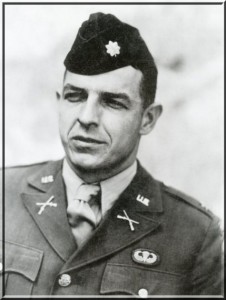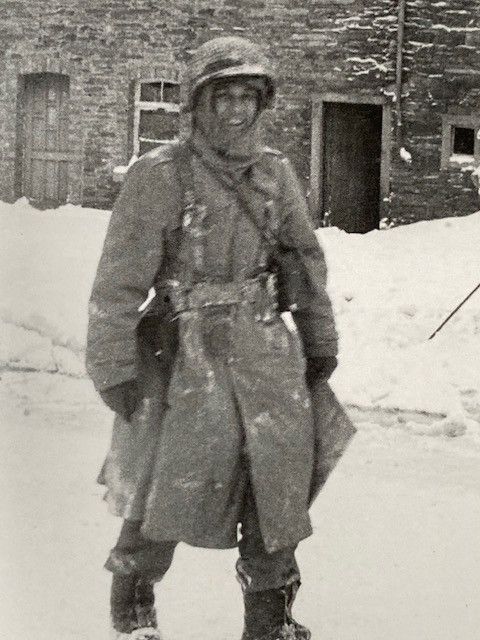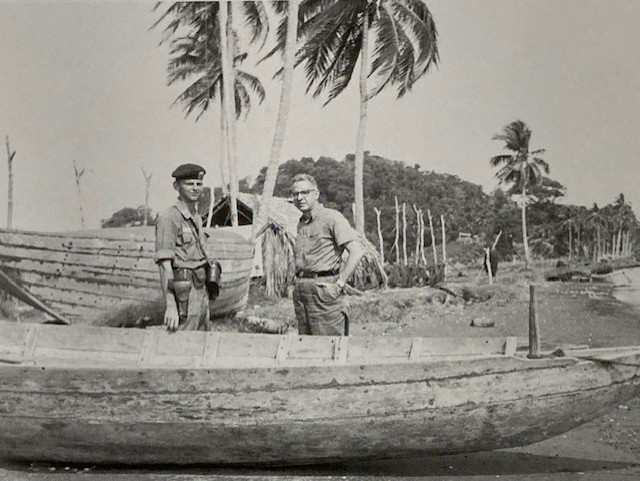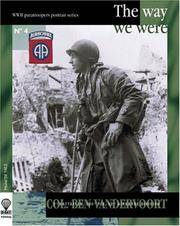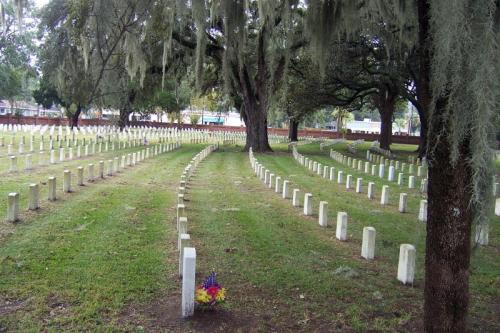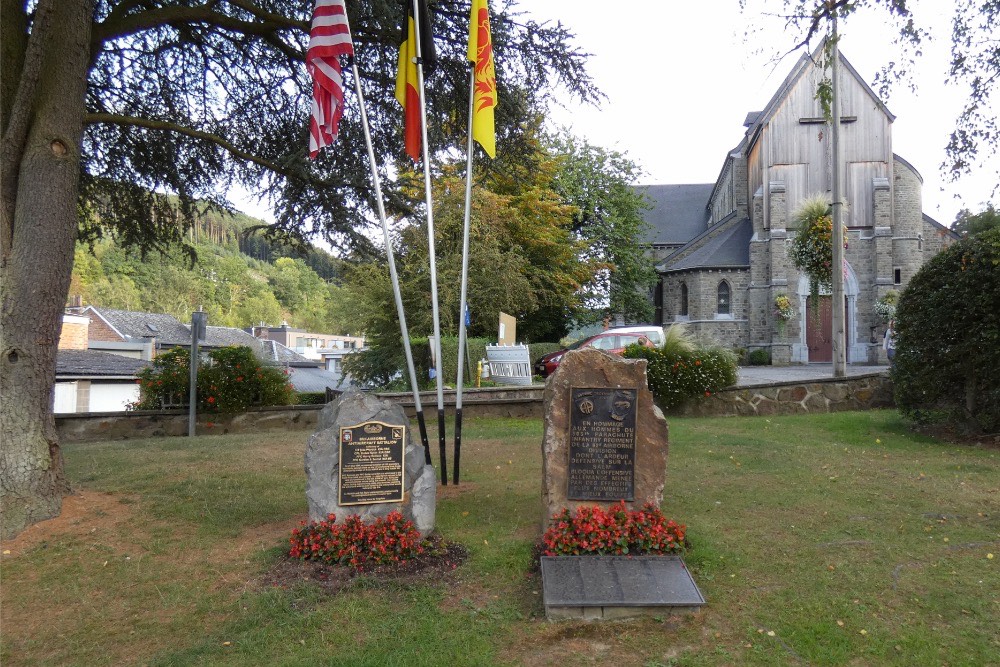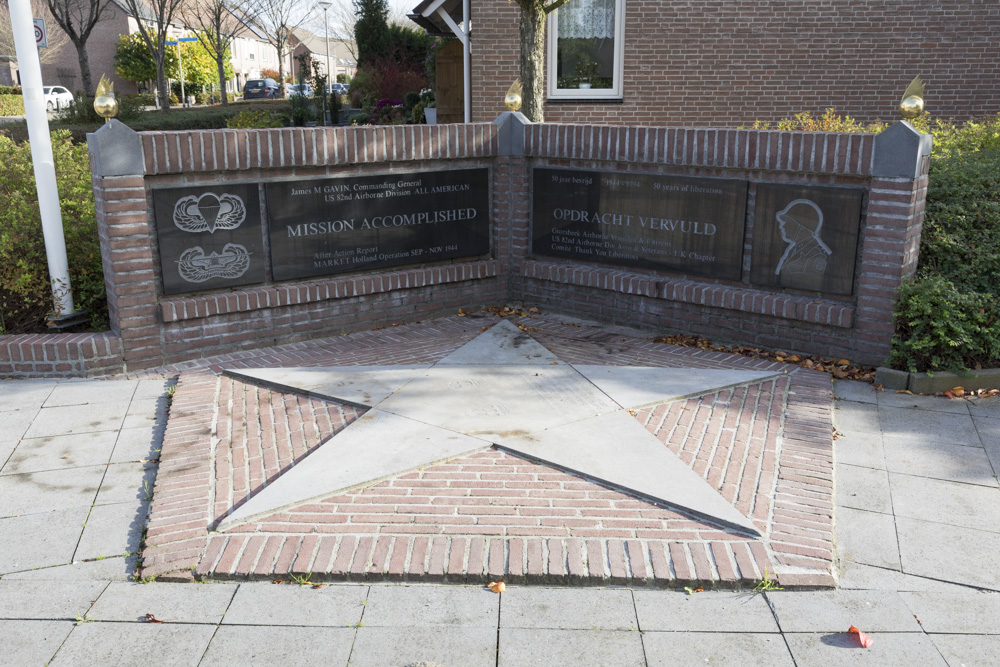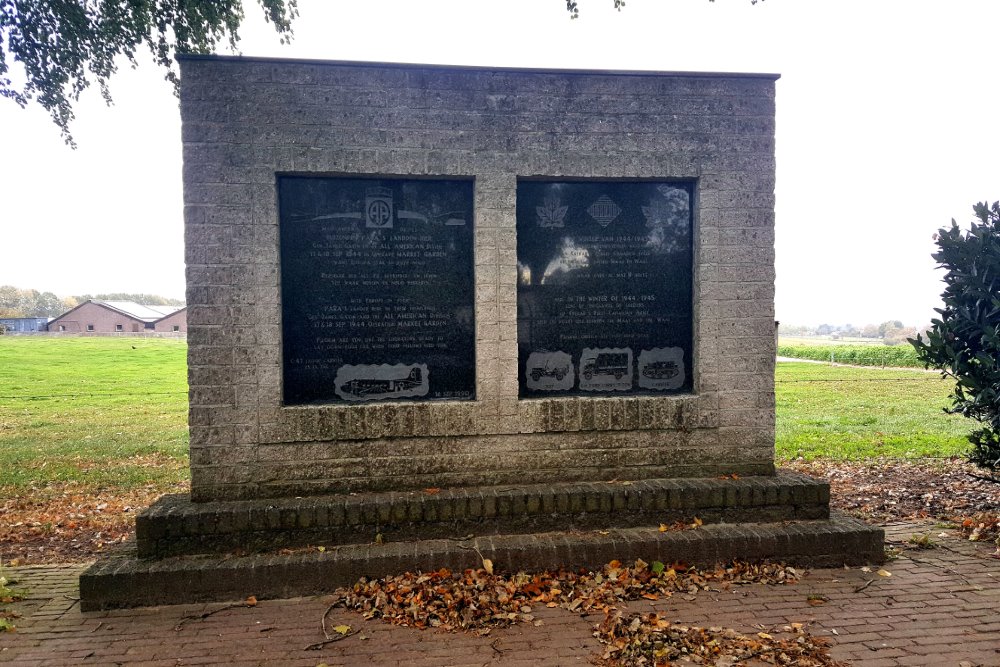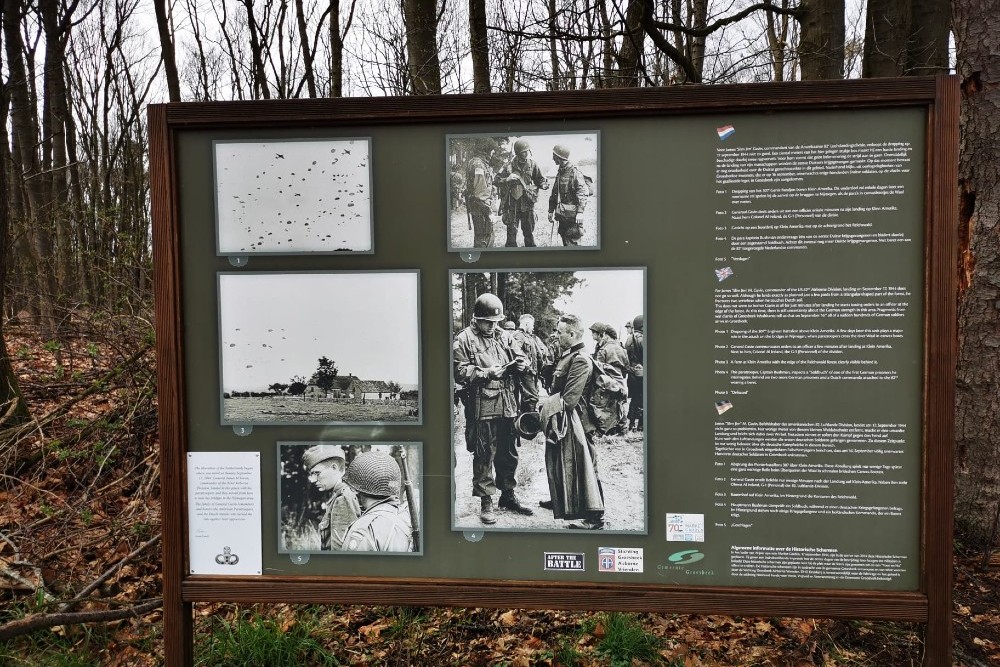Introduction
Colonel Benjamin Hayes 'Vandy' Vandervoort became known to the general public by John Wayne's portrayal in the film classic The Longest Day. However, relatively little is known about Vandervoort's role as one of the pioneers of the American paratroopers and as a combat commander of various operations during the Second World War. For example, the role of his unit in Operation Market Garden in Nijmegen is overshadowed in many sources, films and documentaries by the heroic actions of Major Julian Cook. The role of 'Vandy' in the Ardennes offensive is also often neglected. However, when in 1990 the US Army was faced with the choice which (tactical) commander should be recognized as 'the outstanding battle commander of World War II', that honourable distinction went to ... Colonel Benjamin Hayes Vandervoort.
Definitielijst
- Ardennes offensive
- Battle of the Bulge, “Von Rundstedt offensive“ or “die Wacht am Rhein“. Final large German offensive in the west from December 1944 through January 1945.
- offensive
- Attack on a smaller or larger scale.
- paratroopers
- Airborne Division. Military specialized in parachute landings.
Before the war
Benjamin Hayes Vandervoort was born in Gasport, New York, on March 3, 1915 and grew up in an army family. His father, Benjamin Franklin Vandervoort, was an army officer who had fought during both WWI and WWII and ultimately rose to the rank of colonel.
Benjamin started his military career in July 1937 as a private with the infantry. Furthermore, he studied and received his Bachelor of Science in June 1938. Around that time, having also successfully completed his training with the Citizen Military Training Corps, he was promoted to 2nd lieutenant. He was assigned as a reserve officer to the 11th Infantry Regiment at Fort Benjamin Harrison, Indiana. There he completed his training in the summer of 1939 and was commissioned as a professional 2nd lieutenant in the regular army. He was then assigned to the 10th Infantry Regiment at Fort Hayes, Ohio, where he served as company commander and subsequently as staff officer on the regimental staff.
In the summer of 1940, Vandervoort volunteered for the first Airborne unit that was being formed and became a member of the experimental test platoon assigned to the new 501st Parachute Battalion at Fort Benning, Georgia. He obtained his parachute license on January 21, 1941. During the spring of 1941 he was promoted to captain and commander of B-Company of the 501st Parachute Battalion and a few months later he would also become Operations and Training Officer (head of section S-3) of the Parachute School at Fort Benning.
Definitielijst
- infantry
- Foot soldiers of a given army.
- Regiment
- Part of a division. A division divided into a number of regiments. In the army traditionally the name of the major organised unit of one type of weapon.
During the war
The United States was dragged into World War II on December 7, 1941, after the Japanese surprise attack on Pearl Harbor. However, in the summer of 1941, the US had already become increasingly worried about the rising influence of Hitler's Germany in Central America. The 501st Parachute Battalion was moved to Panama in the fall of 1941. The unit was tasked with defending the Panama Canal region in case it came to an armed conflict. Vandervoort would remain in Panama until June 1942 when he was posted to Fort Benning to assume one of the commanding positions in the newly formed 505th Parachute Infantry Regiment (PIR). In July 1942, the 505th PIR was formally activated and became part of the new 82nd Airborne Division 'All American'. Benjamin became the commander of F-company (of the 2nd Battalion). He had already completed 46 parachute jumps.
Definitielijst
- Infantry
- Foot soldiers of a given army.
- Regiment
- Part of a division. A division divided into a number of regiments. In the army traditionally the name of the major organised unit of one type of weapon.
Italy
In April 1943 the unit was moved to French Morocco and Vandervoort became head of section S-3 (operations and training) of the 505th PIR and was simultaneously promoted to major. He also became the assistant to Lieutenant-colonel James Gavin, the regimental commander of 505th PIR at that time. During the following months, the 82nd Airborne Division would prepare for its first offensive deployment, namely the landing on Sicily, Operation Husky. On the night of July 9 to 10, 1943, Vandervoort and the 'paratroopers' of the 82nd Airborne Division (504th and 505th PIR) landed in Sicily near Piano Lupo to prevent the Axis troops from reaching the entrances to the beaches on the southern side of the island. This facilitated the success of the amphibious landing by the main Allied Forces. Sicily was liberated on August 16, 1943, and the unit subsequently prepared for its second war deployment, first for a few weeks in French Morocco and later in Castelvetrano in Sicily. Operation Avalanche, the Allied landing at Salerno, started on September 9, 1943. On September 14, 1943, Benjamin was dropped with the 505th PIR near Paestum to reinforce the ground forces of the US 5th Army that had been stalled in their advance from the south. In October 1943, he became the commander of the 2nd Battalion of the 505th PIR while the 82nd Airborne Division was still fighting in Italy.
In November 1943, Major Vandervoort and his unit were moved to England on a troopship to prepare for the invasion of Normandy more than six months later.
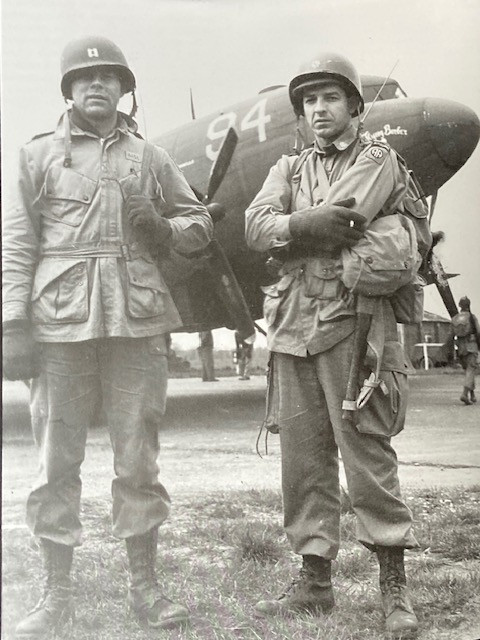
Major Benjamin Vandervoort (right) and his Executive Officer, Captain Hubert, in spring 1944. Source: The Way We Were, No. 4 Col. Ben Vandervoort
Definitielijst
- invasion
- Armed incursion.
- offensive
- Attack on a smaller or larger scale.
- paratroopers
- Airborne Division. Military specialized in parachute landings.
Normandy
>Only 29 years old, Vandervoort was promoted to lieutenant-colonel on June 2, 1944. Three days later, he boarded a C-47 in the evening to make his third operational jump with his unit over Normandy. On June 6, in the dead of night, the new commander jumped with his unit, a few hours ahead of the amphibious invasion. When landing near Sainte-Mère-Église, he broke his left lower leg just above the ankle. He refused to be evacuated and after the lower leg was provisionally splinted, he continued to lead his unit into the liberation of the first town in France, Sainte-Mère-Église. Vandervoort received his first Distinguished Service Cross (DSC) and Purple Heart. Afterwards he would be awarded the Croix de Guerre avec Palme by France. His unit, the 2nd Battalion 505th PIR, received the Presidential Unit Citation.
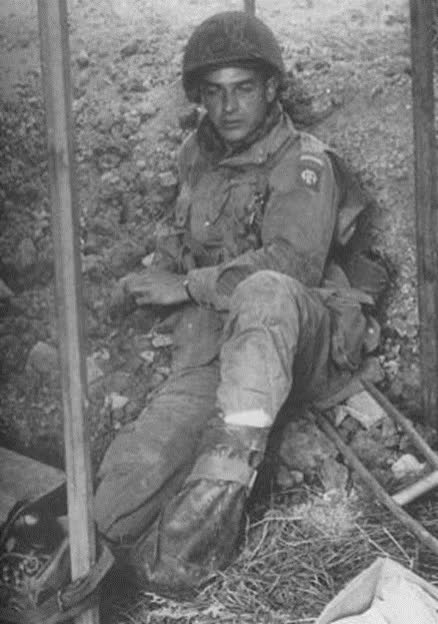
Vandervoort with a broken left lower leg on June 7, 194, in his command post in an orchard in Sainte-Mère-Église. Source: The Way We Were, No. 4 Col. Ben Vandervoort
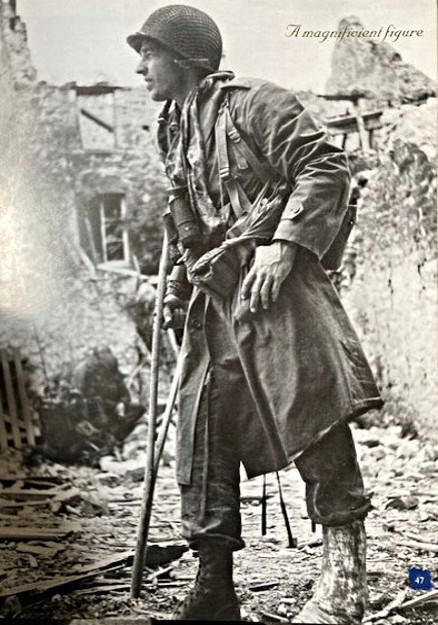
Vandervoort with lower leg in plaster and crutch a few days later in Sainte-Mère-Église. Source: The Way We Were, No. 4 Col. Ben Vandervoort
Definitielijst
- invasion
- Armed incursion.
- Purple Heart
- American military award. Awarded to those who got wounded during war.
Market Garden
Vandervoort returned to England with his unit on July 19, 1944, and prepared for its fourth deployment, as part of Operation Market Garden. On September 17, 1944, Vandervoort landed with his 2nd Battalion 505th PIR in the surrounding area of Groesbeek, where the regiment initially functioned as a division reserve of the 82nd Airborne Division. After the 508th PIR had not succeeded in their attack of the southern approaches to the bridges over the Waal in Nijmegen, Vandervoort was instructed on September 19 to form a formation with his unit, 2nd Battalion 505th PIR, together with British tanks from the Guards Armoured Division and to fight their way to the southern entrances of the two Waal bridges and to secure these. In the meantime, the 3rd Battalion 504th PIR (commanded by Major Cook) was ordered to cross the Waal in boats and then capture the northern side of the bridges. In the afternoon of September 20, 1944, Vandervoort and his unit, reinforced with British tanks, succeeded in securing the southern approaches. Shortly afterwards, Major Cook's paratroopers succeeded in capturing the northern approaches and both bridges over the Waal were in Allied hands.
Vandervoort received the oak leaves for his Distinguished Service Cross and the Bronzen Leeuw from the Dutch state for his heroic leadership under enemy fire during the capture of both bridges. A few weeks after the liberation of Nijmegen, Benjamin and his unit were withdrawn to the area around Reims, Northern France, to recuperate.
Definitielijst
- paratroopers
- Airborne Division. Military specialized in parachute landings.
- regiment
- Part of a division. A division divided into a number of regiments. In the army traditionally the name of the major organised unit of one type of weapon.
The Ardennes
The Germans, with the 6 Panzer Armee, launched a counter-offensive in the Belgian Ardennes on December 16, 1944, in a desperate attempt to recapture Antwerp and thus split and partially defeat the Allied Forces in Western Europe. After the Germans had started their counter-offensive, Vandervoort was urgently moved to Werbemont with his severely undermanned and poorly equipped 2nd Battalion 505th PIR on December 19, 1944, to repel the German attack around Trois Ponts. On December 20, he set up an improvised defence near the town's three bridges to stop the German vanguard troops, the Kampfgruppe Peiper, and prevent them from using those bridges. On December 21, Benjamin and his unit got into a fight, and he was wounded in the right shoulder by a Schmeisser bullet. Nevertheless, he continued to lead his unit and managed to stop the German advance at Trois Ponts on December 22.
The commander and his unit were then involved in several combat actions during the Ardennes offensive. On January 7, 1945, Benjamin was wounded again during an attack with his unit on a German position near Goronne. This time he was hit in the face by fragments from an exploding 80mm mortar. This brought an abrupt end to his operational deployment with his beloved 2nd Battalion 505th PIR, 82nd Airborne Division. After his left eyeball had been surgically removed in Liège on January 12, 1945, he was medically evacuated to the US.
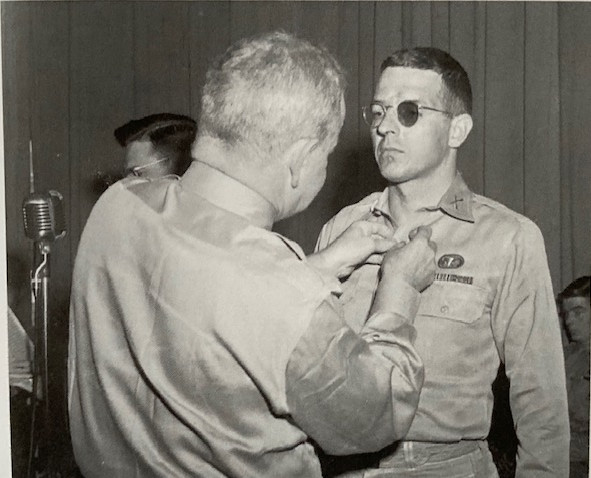
Vandervoort receives his Oak Leaf Cluster from General Bixby, Commanding General War Department Personnel Center in summer 1945. Bixby also presented two Oak Leaf Clusters to Vandervoort for his Purple Heart award on the same occasion. Source: The Way We Were, No. 4 Col. Ben Vandervoort
Definitielijst
- Ardennes offensive
- Battle of the Bulge, “Von Rundstedt offensive“ or “die Wacht am Rhein“. Final large German offensive in the west from December 1944 through January 1945.
- Kampfgruppe
- Temporary military formation in the German army, composed of various units such as armoured division, infantry, artillery, anti-tank units and sometimes engineers, with a special assignment on the battlefield. These Kampfgruppen were usually named after the commander.
- mortar
- Canon that is able to fire its grenades, in a very curved trajectory at short range.
- offensive
- Attack on a smaller or larger scale.
After the war
After returning to the US, he spent many times in hospital until the summer, where he would receive an artificial eye at the end of July. However, his injury forced him to end his short but brilliant career in the army. In the summer of 1946, he was promoted one last time and a few weeks later Benjamin left the US Army with early retirement at the rank of colonel.
Thereafter, he would then work in government service for another twenty years, including for the CIA in Vietnam.
In 1967, Benjamin Hayes Vandervoort retired and subsequently lived a reclusive life in South Carolina. He had been married to Nedra Marlin since 1940 and they had two children. Vandervoort died in November 1990 of serious head injuries after a fall down the stairs. He is buried at the Beaufort National Cemetery, Beaufort, South Carolina, Section 20, Grave 59.
Information
- Article by:
- Sjack van der Voort
- Translated by:
- Simon van der Meulen
- Published on:
- 19-01-2025
- Feedback?
- Send it!
Related sights
Related books
Sources
- AMBROSE, S., Van D-day tot Berlijn, Mynx, 2008.
- BEEVOR, A., De Slag om Arnhem, Ambo Anthos, Amsterdam, 2018.
- CLAY, STEVEN E, U.S. Army Order of Battle, 1919-1941, Volume 1., Fort Leavenworth, KS : Combat Studies Institute Press, 2010.
- DE TREZ, M., Colonel Ben Vandervoort: The Way We Were, D-Day Publishing, Wezembeek-Oppem, Belgium, 2004.
- Memorial/80005103/benjamin-franklin-vandervoort
- US_Army_officers
- 505th Infantry Regiment (United States)
- Togetherweserved
- Operatie-Market-Garden-1
- Operatie-Market-Garden-2
- The 2-505 at Trois Ponts-Battle of the Bulgel
- The 82nd Airborne during World War II Campaigns - Sicily
- The 82nd Airborne during World War II Campaigns - Normandy (D-Day)
- The 82nd Airborne during World War II Campaigns - Rhineland
- Distinguished Unit Citation
- Graven ww2
- Memorial
